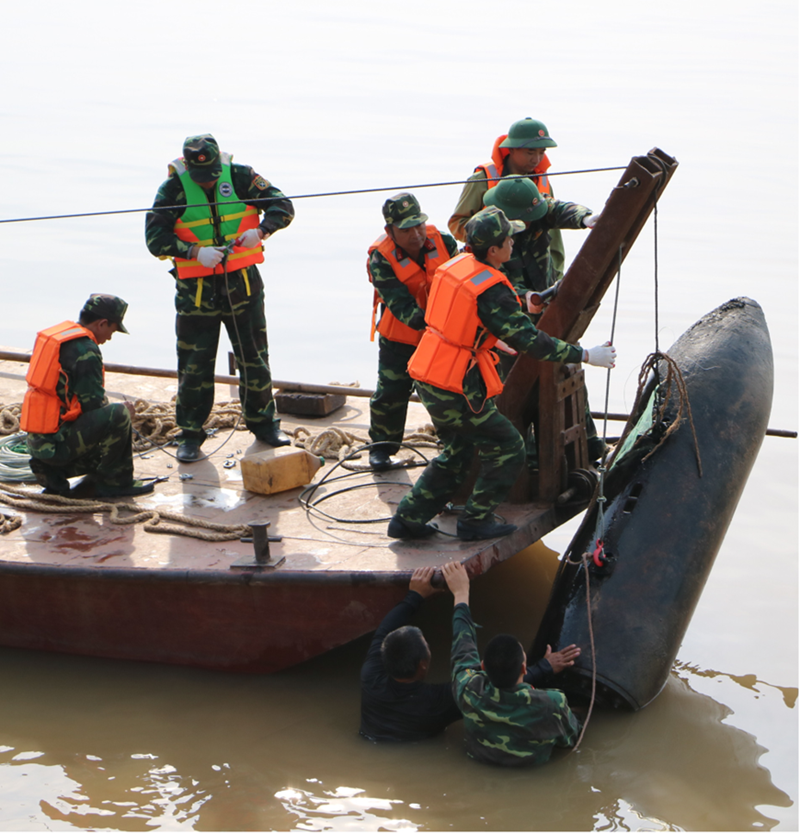Lingering danger
Bombs and mines rob people of their most basic rights, the right to live, to move freely, to work, and to learn. The threat of UXO exists not only in remote or border areas but also in lowlands, residential communities, and even urban centers.
    |
 |
|
Engineering troops preparing to detonate large bombs found in the Central region |
As of June 2025, Vietnam still has about 5.54 million hectares of UXO-contaminated land, nearly 17% of the nation’s total area, with an estimated 800,000 tons of unexploded munition remaining. Since 1975, UXO accidents have killed more than 40,000 people and injured over 60,000, many of them being breadwinners, ethnic minority people, or children. In the Central region, the hardest hit, there have been over 22,800 victims, including more than 10,500 fatalities. In the North, Lang Son Province alone still has about 21,000 hectares of contaminated land. In many rural areas, people continue to live and farm on ground that may still conceal deadly explosives.
These figures underscore the persistent danger UXO poses, not only to human life, but also to livelihoods and development. Millions of hectares of land remain idle for years, halting infrastructure, tourism, and energy projects and driving up investment costs. In some areas, farmers work on their fields in fear, and children still play unaware of dangerous ground. Clearing contaminated land is, therefore, not just about safety, it is key to unlocking rural development, sustainable forestry, infrastructure, and community tourism.
Progress through determined action
With the leadership from the Communist Party, unified management by the State, and the military serving as the core force, Vietnam has achieved notable progress in UXO clearance. Between 2023 and 2024, the Ministry of National Defense, in coordination with ministries, localities, and international partners, surveyed and cleared more than 73,000 hectares nationwide. A significant project was the “UXO clearance for the search and repatriation of martyrs’ remains in Ha Giang Province (2020–2025),” which has cleared 3,200 hectares to date. During the same period, 44 projects were implemented with a total committed aid of USD 138.5 million.
    |
 |
|
Engineers retrieving a large bomb from the riverbed near Long Bien Bridge, Hanoi |
Major General Tran Trung Hoa, Commander of the Engineering Corps and General Director of the Vietnam National Mine Action Center (VNMAC), said that during the 2023–2024 period, the center coordinated closely with ministries, localities, and international organizations to fulfill the objectives of the national UXO remediation program. VNMAC advised authorities on formulating plans, legal frameworks, and training programs to improve resource mobilization and ensure transparent, efficient use of funding for UXO-related activities.
In addition, public awareness and education have also been prioritized, with more than 1,900 direct outreach sessions, hundreds of mobile campaigns, and regular broadcasts on media outlets. Hundreds of educational messages and slogans have been produced. Nearly 1,300 personnel, including team leaders, technicians, quality managers, and supervisors from engineering units, have received specialized training and certification.
International cooperation continues to play an essential role. At a recent donor conference for UXO remediation, U.S. Ambassador to Vietnam Marc Evans Knapper reaffirmed his country’s long-standing partnership with Vietnam in this field. The diplomat said that the U.S. has worked with Vietnam on UXO clearance since 1993. In 2024 alone, the country supported the clearance of 14,000 hectares, detonated 23,000 hazardous items, and assisted 2 million UXO victims. It also trained Vietnamese technicians to enhance their clearance capacity. The U.S. Ambassador affirmed that the country hope all Vietnamese, especially children, can live in a peaceful, safe environment, and will continue to support Vietnam’s efforts to clean up contaminated areas.
Sustained commitment needed
Vietnam still faces vast contaminated areas, complex terrain, and harsh climate conditions. Explosive density is uneven, with many “hotspots” interspersed among villages and farmland. Limited national resources, high clearance costs, and strict safety requirements make the process slow and demanding.
Experts stress the need for stronger coordination among agencies in developing plans, improving legal frameworks, and encouraging domestic and international participation. In addition, public education should also be expanded, integrating UXO safety into school curricula in affected regions, and adopting digital tools such as UXO hazard maps and hotlines.
    |
 |
|
UXO cleared by the Engineering Corps gathered at the demolition site |
At the same time, Vietnam seeks to deepen international cooperation through conferences, workshops, and memoranda of understanding to mobilize financial and technical resources. Further emphasis is needed on scientific research, technological innovation, advanced training, and welfare policies for those working directly in hazardous conditions.
Clearing UXO is a long and challenging journey that demands patience, determination, and responsibility. Through steadfast commitment, Vietnam is gradually healing the wounds of war, spreading humanitarian values, and bringing lasting peace and safety to its people, paving the way for national development.
Translated by Tran Hoai